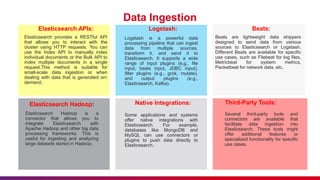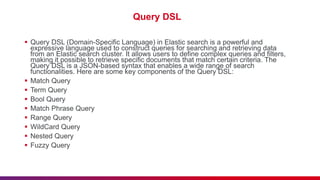Elastic Search Capability Presentation.pptx
- 2. Lack of etiquette and manners is a huge turn off. KnolX Etiquettes Punctuality Join the session 5 minutes prior to the session start time. We start on time and conclude on time! Feedback Make sure to submit a constructive feedback for all sessions as it is very helpful for the presenter. Silent Mode Keep your mobile devices in silent mode, feel free to move out of session in case you need to attend an urgent call. Avoid Disturbance Avoid unwanted chit chat during the session.
- 3. 1. Introduction 2. Elastic Stack(ELK) 3. Basic Architecture 4. Use Cases 5. Data Ingestion 6. Query DSL 7. Performance And Scalability 8. Demo
- 5. Introduction Elastic search is a powerful and open-source search and analytics engine built on top of Apache Lucene. It is designed to handle large amounts of data and is particularly well-suited for real-time search and analysis. Elastic search is a part of the Elastic Stack, which also includes Logstash, Kibana, and Beats. Elastic search is primarily used for full-text search but is also capable of handling various types of structured and unstructured data. Query & analyze structured data. Analyze application logs and system metrics. E.g. errors and CPU/memory usage Send events to Elastic search E.g. sales, website clicks, phone calls etc. Elastic search is great at analyzing lots of data. Anomality Detection.
- 8. Elastic Stack(ELK) The Elastic Stack, formerly known as the ELK Stack, is a collection of open-source tools designed for searching, analyzing, and visualizing data. It is widely used for log and event data analysis, monitoring, and various other data analytics scenarios. Elastic Stack consists of four main components.
- 9. Elasticsearch: Elasticsearch is a distributed search and analytics engine that stores data in a JSON format. It provides powerful search and analytics capabilities, making it the core component of the Elastic Stack. Logstach:Logstash is a data processing pipeline that ingests, processes, and transforms data before sending it to Elasticsearch. It is often used for collecting and parsing log data from various sources, such as application logs, system logs, and network logs. Kibana:Kibana is a web-based visualization tool that allows users to interact with and explore data stored in Elasticsearch. It provides a user-friendly interface for creating dashboards, visualizations, and performing ad-hoc queries. Kibana is an essential component for monitoring and visualizing data in real-time. Beats:Beats are lightweight data shippers that send data from different sources to either Elasticsearch or Logstash.
- 11. Basic Architecture Cluster:A cluster is a collection of nodes that work together and share the same cluster name. Nodes within a cluster communicate and cooperate to distribute data, manage cluster state, and handle queries. Node: A node is a single instance of Elastic search running on a physical or virtual machine. Nodes are the basic building blocks of an Elastic search cluster. Index: An index is a logical collection of documents with similar characteristics or data type. For example, you might have an index for storing user data and another for storing product information. Shard: A shard is a single, self-contained unit of an index that holds a subset of the index's data. Elastic search distributes shards across nodes to enable horizontal scaling and efficient data retrieval. Document:A document is a JSON object representing a piece of data stored in an index
- 13. Website and Application Search: Implementing a fast and efficient search functionality on websites or applications. Elastic search enables full-text search, autocomplete suggestions, and faceted search. Use Cases Log and Event Data Analysis: Analyzing and searching through log files generated by applications, servers, and network devices. Elastic search excels in handling large volumes of log and event data, providing real-time insights and troubleshooting capabilities. Business Intelligence and Analytics: Storing and querying large datasets for business intelligence and analytics purposes. Elasticsearch can handle structured and unstructured data, making it suitable for complex querying and analysis. Monitoring and Alerting: Monitoring the health and performance of systems, applications, and infrastructure in real-time. Elasticsearch, when used in conjunction with tools like Beats and Kibana, forms a powerful monitoring and alerting solution. Security Information and Event Management (SIEM): Centralizing and analyzing security-related data, including logs, alerts, and events. Elasticsearch is a key component in building SIEM solutions for threat detection and response. Content and Document Management: Managing and searching through large repositories of documents or content. Elasticsearch allows for full-text search, document retrieval, and supports complex queries, making it valuable for content management systems.
- 14. E-commerce Search and Recommendations: Enhancing the search experience on e-commerce platforms by providing relevant and fast search results. Elastic search can also be used for building recommendation engines based on user behavior and preferences. Use Cases Geospatial Data Analysis: Analyzing and searching through geospatial data, such as locations and coordinates. Elasticsearch supports geospatial queries, making it suitable for applications involving maps, geolocation-based services, and spatial analysis. Healthcare Data Search: Indexing and searching through vast amounts of healthcare data, including electronic health records (EHRs) and medical documents. Elasticsearch enables quick retrieval of relevant medical information. Social Media Monitoring: Tracking and analyzing social media data for sentiment analysis, trend identification, and brand monitoring. Elastic search can process and index large amounts of social media data in real-time. Data Exploration and Visualization: Building interactive dashboards and visualizations for exploring and understanding large datasets. Kibana, when integrated with Elasticsearch, facilitates data exploration and visualization. Data Integration and Enrichment: Integrating data from multiple sources, enriching it, and making it searchable. Logstash, a component of the Elastic Stack, is often used for data integration and transformation.
- 16. Elasticsearch APIs: Elasticsearch provides a RESTful API that allows you to interact with the cluster using HTTP requests. You can use the Index API to manually index individual documents or the Bulk API to index multiple documents in a single request.This method is suitable for small-scale data ingestion or when dealing with data that is generated on- demand. Data Ingestion Logstash: Logstash is a powerful data processing pipeline that can ingest data from multiple sources, transform it, and send it to Elasticsearch. It supports a wide range of input plugins (e.g., file input, beats input, JDBC input), filter plugins (e.g., grok, mutate), and output plugins (e.g., Elasticsearch, Kafka). Beats: Beats are lightweight data shippers designed to send data from various sources to Elasticsearch or Logstash. Different Beats are available for specific use cases, such as Filebeat for log files, Metricbeat for system metrics, Packetbeat for network data, etc. Elasticsearch Hadoop: Elasticsearch Hadoop is a connector that allows you to integrate Elasticsearch with Apache Hadoop and other big data processing frameworks. This is useful for ingesting and analyzing large datasets stored in Hadoop. Native Integrations: Some applications and systems offer native integrations with Elasticsearch. For example, databases like MongoDB and MySQL can use connectors or plugins to push data directly to Elasticsearch. Third-Party Tools: Several third-party tools and connectors are available that facilitate data ingestion into Elasticsearch. These tools might offer additional features or specialized functionality for specific use cases.
- 18. Query DSL Query DSL (Domain-Specific Language) in Elastic search is a powerful and expressive language used to construct queries for searching and retrieving data from an Elastic search cluster. It allows users to define complex queries and filters, making it possible to retrieve specific documents that match certain criteria. The Query DSL is a JSON-based syntax that enables a wide range of search functionalities. Here are some key components of the Query DSL: Match Query Term Query Bool Query Match Phrase Query Range Query WildCard Query Nested Query Fuzzy Query
- 20. Performance And Scalability Performance and scalability are critical considerations when designing an Elastic search cluster, especially for handling large volumes of data and supporting high query loads. Here are key factors and strategies to optimize performance and scalability in Elastic search: Hardware and Infrastructure Cluster Configuration Sharding Indexing Performance Query Performance Caching Monitoring and Logging Tune JVM setting Data Archiving and Lifecycle Policies Horizontal Scaling Network and Security






















